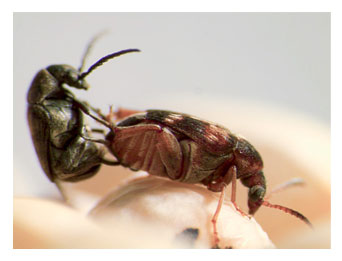Seed Beetle
 The bean weevils or seed beetles are a subfamily (Bruchinae) of beetles, now placed in the family Chrysomelidae, though they have historically been treated as a separate family. They are granivores, and typically infest various kinds of seeds or beans, living for most of their lives inside a single seed. The family includes about 1,350 species found worldwide.
The bean weevils or seed beetles are a subfamily (Bruchinae) of beetles, now placed in the family Chrysomelidae, though they have historically been treated as a separate family. They are granivores, and typically infest various kinds of seeds or beans, living for most of their lives inside a single seed. The family includes about 1,350 species found worldwide.
Bean weevils are generally compact and oval in shape, with small heads somewhat bent under. Sizes range to 1 mm, up to 22 mm for some tropical species. Colors are usually black or brown, often with mottled patterns. Although their mandibles may be elongate, they do not have the long snouts characteristic of true weevils.
Adults deposit eggs on seeds, then the larvae chew their way into the seed. When ready to pupate, the larvae typically cut an exit hole, then return to their feeding chamber. Adult weevils have a habit of feigning death and dropping from a plant when disturbed.
Host plants tend to be legumes, but species will also be found in Convolvulaceae, Arecaceae, and Malvaceae, and several species are considered pests.
One characteristic of the beetles which can be seen in the photo is that the elytra are short, not quite reaching the tip of the abdomen.
Control of these pests is best achieved by locating and eliminating the source product. Pesticide control efforts are not recommended.
Source elimination is the key.
 The bean weevils or seed beetles are a subfamily (Bruchinae) of beetles, now placed in the family Chrysomelidae, though they have historically been treated as a separate family. They are granivores, and typically infest various kinds of seeds or beans, living for most of their lives inside a single seed. The family includes about 1,350 species found worldwide.
The bean weevils or seed beetles are a subfamily (Bruchinae) of beetles, now placed in the family Chrysomelidae, though they have historically been treated as a separate family. They are granivores, and typically infest various kinds of seeds or beans, living for most of their lives inside a single seed. The family includes about 1,350 species found worldwide.